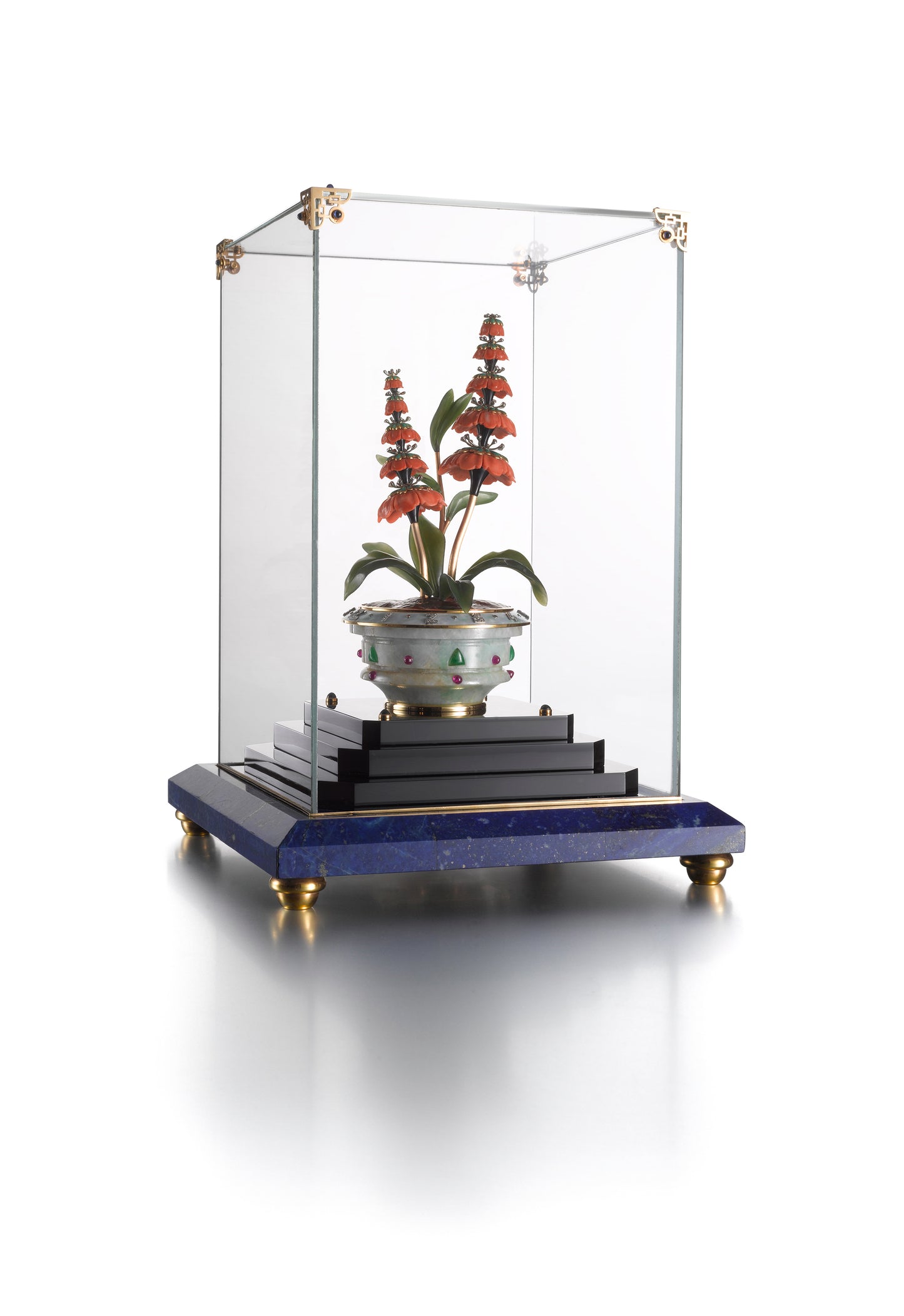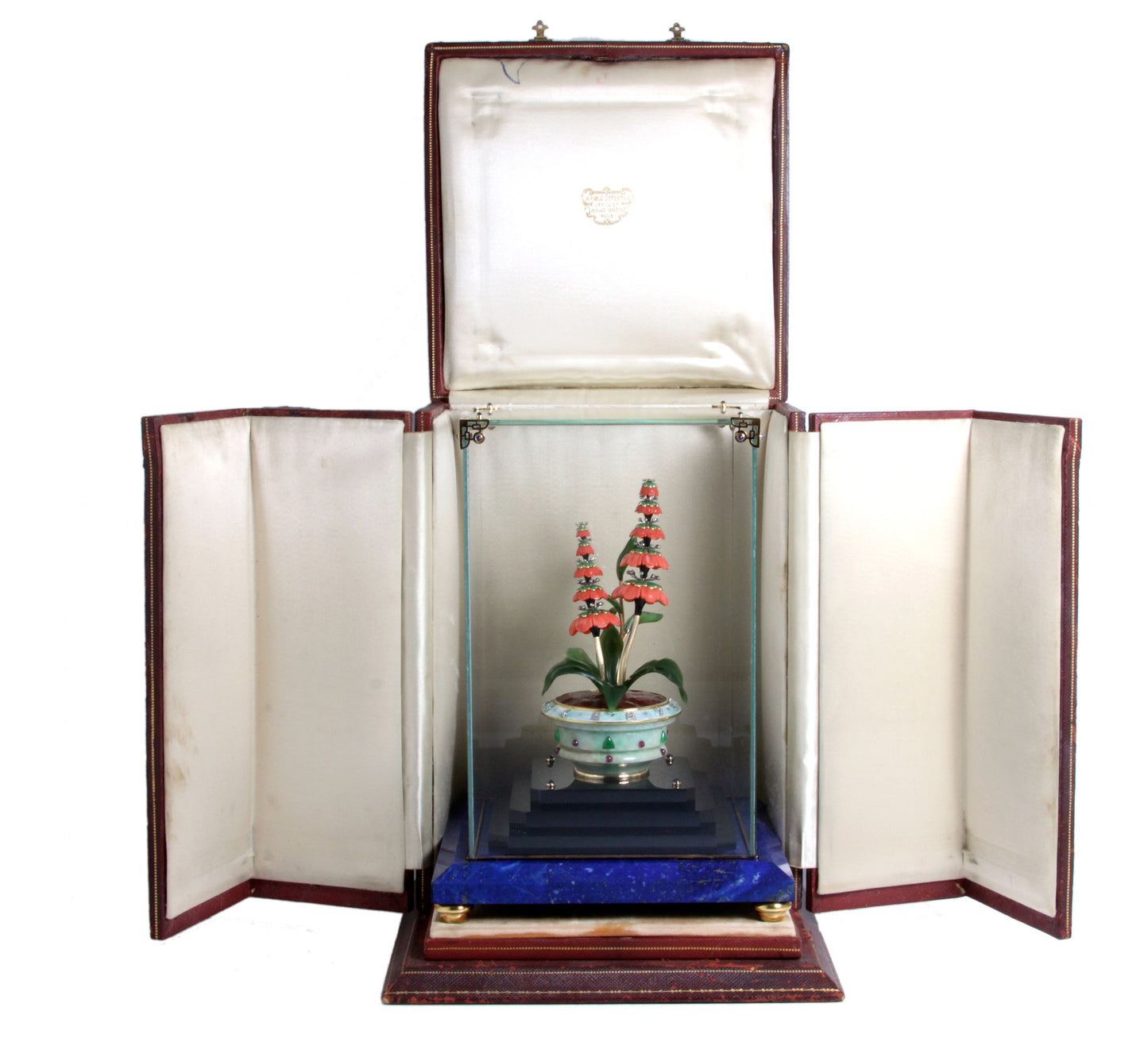GEM-SET CORAL AND HARDSTONE POTTED FLOWER ANNULAR DESK CLOCK BY VERGER FRÈRES FOR OSTERTAG, PARIS, CIRCA 1929
GEM-SET CORAL AND HARDSTONE POTTED FLOWER ANNULAR DESK CLOCK BY VERGER FRÈRES FOR OSTERTAG, PARIS, CIRCA 1929
SOLD
A clock designed as a gem-set jadeite flowerpot with stylized carved coral Fritillaria imperialis flowers and jadeite leaves, the rotating chapter ring designed as the rim of the pot with diamond-set Arabic numerals, the time indicated by one angled leaf, the whole surmounted upon a stepped onyx base enhanced with cabochon sapphires at the corners, containing the 15-jewel rectangular movement, all raised on a beveled lapis lazuli base with four gold feet, all contained within a square glass outer case, the corners fitted with gold cabochon sapphire-set openwork
- Base signed by Ostertag, movement signed by Vacheron Constantin, no. 404672
Additional cataloguing
Provenance
- Mrs. Mae Caldwell Manwaring Plant Hayward Rovensky
Literature
- cf. Cologni, Franco, and Dominque Flechon. The Secrets of Vacheron Constantin: 250 Years of History. Paris: Flammarion, 2005, p. 333.
Biography
In the Art Deco period, Verger Frères, was an important manufacturer of clocks and jewelry for all of the great jewelry houses. During the 1920s and 1930s, the firm worked with the Vacheron & Constantin, one of the oldest French watchmaking companies. With Vacheron & Constantin creating movements and Verger Frères the cases, retailers such as Ostertag, a Parisian jewelry company known for colorful designs, sold their innovative timepieces, along with Van Cleef & Arpels, Cartier, Tiffany, and Boucheron.
Significance
In contrast to the all-white look of jewelry and objects of art from the first two decades of the twentieth century, color dominated the 1920’s, an era known as Art Deco. Coral, lapis lazuli, and jadeite were juxtaposed with diamonds and other precious gemstones. The style was characterized by a rectilinear paradigm; however, naturalistic motifs remained part of the vernacular often in conjunction with geometric forms. This clock is such an example. An artfully created flower, a stylization of Fritillaria imperialis, is set into a jadeite pot with one leaf marking time on the rotating dial. The flowerpot is set upon a stepped onyx base, surmounted on a lapis lazuli plinth forming a pedestal that presents the flower as a piece of sculpture.
This special clock is the collaboration of two important makers. Vacheron & Constantin supplied the clock mechanism while Verger Frères created the flowerpot and base. It was common during this time period that makers such as Verger did not always stamp their mark on jewelry and objects of art. Each piece bore characteristics of a particular maker’s style. The clock was retailed by Ostertag, whose reputation in the 1920’s and 1930’s rivaled other important Parisian jewelers.
This clock was formerly in the collection of Mrs. Mae Rovensky, whose reputation as an astute collector was evident in the sale of her paintings,tapestries, furniture, and decorative arts that sold at Parke-Bernet Galleries in 1957. Included in her collection were paintings by François Boucher, Jean- Antoine Watteau, Sir Thomas Lawrence, and George Romney as well as examples of English silver, Meissen porcelain, and Royal Beauvais tapestries.In the world of jewelry, she is best known for her acquisition of a two-strand Oriental pearl necklace, valued at the time at $1 million, that she and her second husband, Morton F. Plant of Southern Express Company and Atlantic Coastline Railroad, traded in 1917 with Cartier for their town house at 721 Fifth Avenue. Cartier still maintains their business at this location in the former Plant mansion.
This special clock is a testament to the time when it was made, the maker’s who created it and the astute collectors who owned it. Rarely does such an important object of art come onto the market that is not only beautiful but also has an illustrious history.

















